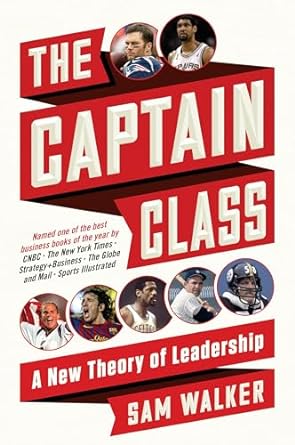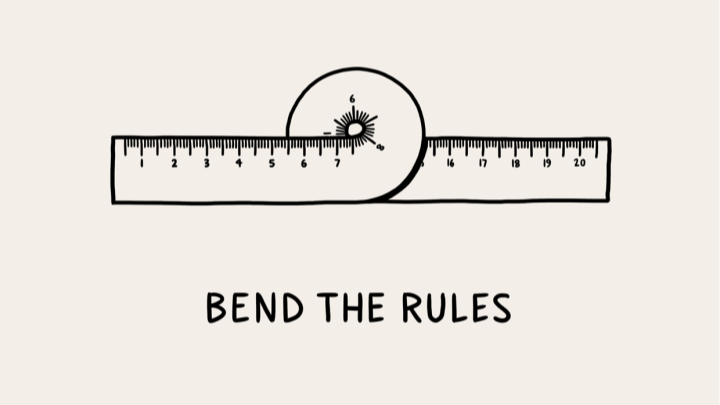
I recently finished a fascinating book and this week wanted to share it with you. I’ve played on, coached, and facilitated hundreds of teams over the years and it can be incredibly difficult to put your finger on exactly what each team’s needs are. In his 2017 book, The Captain Class, Sam Walker tackled this valuable topic by identifying the world’s most successful professional sports teams in recorded history and determined the single throughline that was consistent among each of the 17 most successful dynasties across all sports. He realized that it was not the coach, the owner or necessarily having the best player of the era that enabled teams to achieve sustained greatness… instead it was the team Captains. In this article, I share keys from the book and some ideas for how we can apply them to our projects and teams.

Part 1 – Defining the elite teams
Establishing the top 17 sports dynasties was a surprisingly complex task. Each team needed to compete at the highest possible level in their sport. Further, they needed to win multiple championships and trophies over a sustained period and must be the best in their respective sport. A perfect example is the inclusion of the Boston Celtics (who one 8 championships in 11 years) and the San Antonio Spurs (5 championships in 18 years), but the exclusion of Michael Jordan’s Chicago Bulls (who won 6 championships in a 9 year span) who experienced a higher peak, but lacked sustained greatness due to Jordan’s departure for baseball midway through. Further, he researched the “before” and “after” each respective captain was a member of their team and noted how each club had a marked drop in performance when the captain left.
The book focused on 17 teams with 21 Captains including:
Collingwood Magpies (Australian Rules Football), 1927-30, Captain: Syd Coventry
New York Yankees (Major League Baseball), 1949-53, Captain: Yogi Berra
Hungary (Men’s Soccer), 1950-55, Captain: Ferenc Puskas
Montreal Canadiens (National Hockey League), 1955-60, Captain: Maurice Richard
Boston Celtics (National Basketball Association/NBA), 1956-69, Captain: Bill Russel
Brazil (Men’s Soccer), 1958-62, Captain: Hilderaldo Bellini
Pittsburgh Steelers (National Football League/NFL), 1974-80, Captain: Jack Lambert
Soviet Union (Men’s Ice Hockey), 1980-84, Captain: Valeri Vasiliev
New Zealand All Blacks (Rugby Union), 1986-90, Captain: Wayne Shelford
Cuba (Women’s Volleyball), 1991-2000, Captain: Mireya Luis
Australia (Women’s Field Hockey), 1993-2000, Captain: Rechelle Hawkes
United States (Women’s Soccer), 1996-99, Captain: Carla Overbeck
San Antonio Spurs (NBA), 1997-2016, Captain: Tim Duncan
New England Patriots (NFL), 2001-18, Captain: Tom Brady
Barcelona (Professional Soccer), 2008-13, Captain: Carles Puyol
France (Men’s Handball), 2008-15, Captain: Jerome Fernandex
New Zealand All Blacks (Rugby Union), 2011-15, Captain: Richie McCaw
Part 2 – Success Factors
The next part of the book analyzes the key success factors for each of these teams and steps through Sam Walkers initial theories about why each of these teams were so successful. He tested five credible alternative theories:
It takes a standout player of exceptional quality – the greatest of all time.
It’s a matter of overall talent – there was a cluster of exceptional talent that together achieved a set of championships
It’s the money – top spending clubs get the best results
It’s the management – the club owner/general manager and staff
It’s the coach – the club had sustained success when one coach oversaw the team
In the book, Walker examines each of these theories, but found them to be correlational, not causal.
Think about it, for our construction projects, the most outstanding teams are not the ones with the most “intellectual talent,” the best individual craftspeople, or the best leaders from owner and contractor’s management teams. Further, while it is certainly helpful for project teams to have a healthy contingency or a client that is well funded, it’s not just about the money. Instead, we need to look closer at the Superintendents who run our field and the Project Managers who support the administration of our projects to reveal the teams who routinely get the best results, despite the challenges of the project or the constraints handed to them.

Part 3 – The Captain Class
The primary lesson that I pulled from this book is that the leaders of the world’s most impactful “winning” teams had some consistent personality and leadership traits. Further, I believe that while a few of these apply better to athletics then to business (ahem… aggressive play), we can absolutely use these as a checklist to identify our best field leaders, Project Managers, and Operations Managers. Very few of the captains listed above had the greatest physical gifts. For the soccer teams you don’t see Pele or Messi; for baseball you don’t see Babe Ruth, Willie Mays, or Mike Trout; and in football while Tom Brady is listed, you don’t have to do too much Googling to find his infamous NFL combine photo or watch him run an incredibly slow 40-yard dash. Most of the people on this list carried supporting roles in the shadows and if they happened to be the star player, did not seek the limelight. As I read the book what was revealed to me was how closely these seven traits so closely resembled the descriptions of the Level 5 leaders described in James Collins’ book, Good to Great. I’ll list them and explain how we can apply this to our projects moving forward.
1. Extreme doggedness/competitive drive
Each of the 17 captains in the class showed competitiveness that tested the boundaries of human physical and mental capability. Think about it, to have one successful team it takes tremendous commitment. To build a dynasty, you need to be near obsessive in your pursuit of greatness and need to be able to adapt and overcome when every other professional team is spending their entire season working to beat you. Famous NBA coach and General Manager, Pat Riley, called it the “disease of me,” when a team would win a championship and then each individual player would seek more responsibility and a pay raise somewhere else. Each of the captains in this book had a story about playing through extreme physical discomfort (I’ll spare the details about Wayne Shelford from the New Zealand All Blacks, but it’s insane) and/or mental anguish (Jerome Fernandex performing in critical moments while privately mourning the death of his father), and yet still showing (not telling) their team how to get the result they needed.
For our team, look for leaders who seem to inspire other team members through their work ethic or, perhaps, a competitive drive. In construction the best leaders done’t “win” each transaction or negotiation, they inspire project teams to achieve outstanding results over and over again. For example, when Partnering Steering Committees launch recognition programs, over and over again we have seen the award-winning project leaders quickly elevate in their organizations!
2. Aggressive play that tests the limits of the rules
In the book, there were many examples of athletes testing the rules. Carles Puyol of FC Barcelona comes to mind with his hard tackles and physical play that served as the counterpoint to the beautiful ball-control style that enabled the club to reach unprecedented heights during his captaincy.
For our teams, I’m conveniently ignoring “aggressive play,” but highlighting the “testing of the rules.” To me the essence of Partnering is to determine where you can “bend – not break” the rules and identify creative solutions to achieve the quality desired, the design vision anticipated, and the schedule at the same time. You need to take risks, be aggressive at times, and the team always needs to find compromise when elements of the “rules” are not serving them. This need for creativity works both in sport and in our workplace.

3. Willing to do thankless jobs in the shadows
Tim Duncan aka Mr. Fundamental from the San Antonio Spurs could score the ball, could rebound and most importantly did small things on the defensive end of the floor that helped ensure the team would win games. He did not seem to care if he scored 10 points or 30 if the team won. Bill Russell of the Boston Celtics was a defensive Mastermind and absolutely did not want to be in the spotlight. Both of these leaders were outstanding players who could have scored more points along the way, but instead, they focused on doing the small things to help ensure winning occurred.
On our projects, little things done in the shadows can go a long way and leaders who “do what it takes” make their teams more successful. Sometimes an engineer from the contractor’s team is the person best suited to do a pencil drawing of the field condition that the owner’s engineering team can then translate into the design. Think of teams who are able to set up an efficient process for payment, or who are able to develop aligned submittals on revision 1 or 2. By aligning quickly, teams can save thousands of dollars per submittal. This type of efficiency can really add up on our projects, both large and small, and yet we don’t often highlight this type of incremental success.
4. Low key practical and democratic communication style
In nearly every case, the world’s most successful captains tended to lead by example much more than they spoke the vision of success. Many of the “Captain Class” had introverted styles and weren’t outstanding public speakers. These were not press darlings who give amazing quotes and stories to the media all the time. In fact, they tended to undersell their own contributions and offer only generic statements about how the team performed. They also helped minimize drama within the locker room and rarely poked their head up unless there was an extreme need to change something in order to impact the on-field result.
For our project teams, I look for this type of communication style. Teams that are overly hierarchical quickly become political and DO NOT get the best results. Great project leaders are able to develop a democratic communication style where anyone on the team can offer up the best idea and the team can quickly agree to implement it. One idea to help foster this type of environment is to let the least senior people speak first in meetings and have the individuals with the highest rank speak last. When the person in charge talks first, they tend to anchor a team, which can minimize the best possible results.
5. Motivates others with passionate non-verbal displays
Tim Duncan (mentioned earlier) was well known for communicating with eye contact and close physical conversations rather than giving “rah-rah” type speeches. This style of leadership was well documented throughout the book, from Carla Overbeck of the U.S. Women’s National Soccer team to Ferenc Puskas, the confident and understated midfielder who set an incredible tone for the Hungarian Men’s national team who shocked the world with their winning total football style of play.
We see these non-verbal displays with great teams in Partnering sessions. I’ve been able to see “winning habits” in meetings where you can see staccato style (short productive bursts) of communication and observe teams swiftly move through conflict to arrive at the optimal answer. You can feel a team that has psychological safety, and they make regular eye contact and work together quickly and effectively.

6. Strong convictions and the courage to stand apart
Each of the leaders in the book did not lead in traditional ways. They would stand up to management, opponents, referees… anyone who would get in the way of them guiding their team along the vision and path they had established as critical. Maintaining excellence through injury, turn over, and all sorts of distractions in professional sports is an incredibly difficult tightrope to balance on.
For our project leaders, developing a highly collaborative environment and getting high performing teams means that you need to be more committed to the project outcome than individual corporate interests or your personal agenda. Leaders don’t always win Miss Congeniality Awards or toe the corporate line. As leaders, we need to enable project teams this latitude, because often the goodwill a compromise creates leads to better results in the end.
7. Ironclad emotional control
Each of the leaders were able to exhibit incredibly strong emotional control. These were not the highly emotional diva-type athletes who could fly off the handle. Instead, they tended to be calm and almost stoic types who “went about their business” rather than make each individual performance about them. This process-focus and ability to control and hone emotions is in and of itself an incredibly important leadership quality.
For our project teams, when leaders are able to maintain control and channel emotion into the optimal work product, it creates a more desirable environment in which to deliver results. To me, this is the most under-emphasized element of athletic leadership and one of the great pearls of wisdom I took from this book. It takes a high level of emotional intelligence to create a sustained winning environment over multiple seasons. Think about it – when leaders on construction projects routinely fly off the handle, everyone else has to bend over backwards to return the project to normal. In sport, and in business, the steady hand will win over time.
So, as you are identifying, supporting, and grooming your project’s leaders, take some of these leadership qualities into account. The best leaders are not necessarily the star players. They are not the obvious, most talkative rah-rah person. In fact, the best leaders who can create a prolonged winning culture tend to be more process-motivated, internally competitive, and will show you (rather than tell you) what success looks like.
I encourage you to take a look at this book and discuss it with your teams. Happy reading!
-Rob
Rob Reaugh is President of OrgMetrics LLC. He facilitates the City and County of San Francisco Collaborative Partnering Steering Committee and currently works with San Francisco International Airport, San Jose International Airport, BART, Caltrans, and others. He holds a Masters’ Degree in Alternative Dispute Resolution.
For more information please contact Rob Reaugh, RobReaugh@Orgmet.com / (925) 487-2404 (cell), or OrgMetrics, (925) 449-8300.


 Rob Reaugh is President of OrgMetrics LLC. He facilitates the City and County of San Francisco Collaborative Partnering Steering Committee and currently works with San Francisco International Airport, San Jose International Airport, BART, Caltrans, and others. He holds a Masters’ Degree in Alternative Dispute Resolution.
Rob Reaugh is President of OrgMetrics LLC. He facilitates the City and County of San Francisco Collaborative Partnering Steering Committee and currently works with San Francisco International Airport, San Jose International Airport, BART, Caltrans, and others. He holds a Masters’ Degree in Alternative Dispute Resolution.